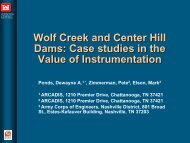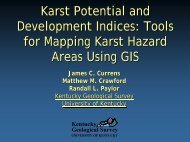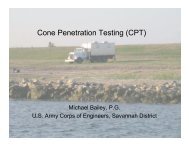Assessing the Slaking Behavior of Clay-Bearing Rocks - Marshall ...
Assessing the Slaking Behavior of Clay-Bearing Rocks - Marshall ...
Assessing the Slaking Behavior of Clay-Bearing Rocks - Marshall ...
You also want an ePaper? Increase the reach of your titles
YUMPU automatically turns print PDFs into web optimized ePapers that Google loves.
<strong>Assessing</strong> <strong>the</strong> <strong>Slaking</strong> <strong>Behavior</strong> <strong>of</strong><br />
<strong>Clay</strong>-<strong>Bearing</strong> <strong>Rocks</strong><br />
Abdul Shakoor<br />
Tej P. Gautam<br />
Department <strong>of</strong> Geology, Kent State University<br />
10 th Annual Technical Forum<br />
GEOHAZARDS IMPACTING TRANSPORTATION IN<br />
THE APPALACHIAN REGION<br />
Columbus, OHIO
SHALES<br />
CLAYSTONES<br />
MUDSTONES<br />
SILTSTONES<br />
CLAY-BEARING ROCKS<br />
Comprise approximately two-thirds <strong>of</strong> <strong>the</strong> stratigraphic column<br />
Cover one-third <strong>of</strong> <strong>the</strong> total land area<br />
Deteriorate rapidly upon exposure to atmospheric processes (low<br />
durability)<br />
Because <strong>of</strong> <strong>the</strong>ir low durability, clay-bearing rocks result in<br />
numerous problems in engineering construction, especially slope<br />
stability
A slope failure in<br />
Pittsburgh caused by<br />
low-durability<br />
claystone
A slope failure in Ohio<br />
caused by low-durability<br />
claystone/mudstone
FIELD BEHAVIOR OF CLAY-BEARING ROCKS<br />
Newly excavated rock mass<br />
Because <strong>of</strong> extensive<br />
disintegration, it is hard<br />
to find an intact rock<br />
block<br />
One year after<br />
excavation
RESEARCH OBJECTIVES<br />
Assess <strong>the</strong> slaking<br />
behavior <strong>of</strong> clay-bearing<br />
rocks under natural<br />
atmospheric conditions<br />
and quantify <strong>the</strong> nature<br />
<strong>of</strong> slaked material in<br />
terms <strong>of</strong> grain size<br />
distribution.
Twenty different clay-bearing rocks<br />
were selected for <strong>the</strong> study including:<br />
5 shales<br />
5 claystones<br />
5 mudstones<br />
5 siltstones
SAMPLE LOCATION AND CLASSIFICATION<br />
Potter et al. (1980)<br />
classification was<br />
used to classify<br />
samples into<br />
shales, claystones,<br />
mudstones, and<br />
siltstones<br />
Laboratory Tests:<br />
Slake durability index (I d2 , I d3 , I d4 , I d5 )<br />
Grain size distribution <strong>of</strong> <strong>the</strong> slaked material<br />
retained in 2 mm-mesh drum after <strong>the</strong> test
Slake Durability Test Apparatus
GSD <strong>of</strong> Slaked Material (Lab)<br />
100<br />
Shale (2)<br />
100<br />
Mudstone (3)<br />
Percent retained by weight<br />
80<br />
60<br />
40<br />
20<br />
0<br />
100<br />
Cycle 1<br />
Cycle 2<br />
Cycle 3<br />
Cycle 4<br />
Cycle 5<br />
10<br />
Particle size (mm)<br />
1<br />
Percent retained by weight<br />
80<br />
60<br />
40<br />
20<br />
0<br />
100<br />
Cycle 1<br />
Cycle 2<br />
Cycle 3<br />
Cycle 4<br />
Cycle 5<br />
10<br />
Particle size (mm)<br />
1<br />
Shale<br />
Mudstone<br />
Percent retained by weight<br />
100<br />
80<br />
60<br />
40<br />
20<br />
0<br />
100<br />
Cycle 1<br />
Cycle 2<br />
Cycle 3<br />
Cycle 4<br />
Cycle 5<br />
<strong>Clay</strong>stone (1)<br />
10<br />
Particle size (mm)<br />
1<br />
Samples after 5 th cycle<br />
Percent retained by weight<br />
100<br />
80<br />
60<br />
40<br />
20<br />
0<br />
100<br />
Cycle 1<br />
Cycle 2<br />
Cycle 3<br />
Cycle 4<br />
Cycle 5<br />
Siltstone (3)<br />
10<br />
Particle size (mm)<br />
1<br />
<strong>Clay</strong>stone<br />
Siltstone
Simulation <strong>of</strong> Field <strong>Slaking</strong> <strong>Behavior</strong><br />
• Twelve replicate samples <strong>of</strong> each <strong>of</strong> twenty claybearing<br />
rocks were prepared. Each sample consisted<br />
<strong>of</strong> 10 pieces, weighing 40-60 g, with a total weight<br />
<strong>of</strong> 450 to 550 g. All sample pieces were retained on<br />
1-inch sieve.<br />
• Each replicate sample was placed in a 9-inch<br />
diameter pan and exposed to natural climatic<br />
conditions for 1 year period, from September 2009<br />
to September 2010.<br />
• After each month, one sample <strong>of</strong> each <strong>of</strong> four rock<br />
types was removed and its grain size distribution<br />
was determined.
Samples Being Exposed to Natural Climatic Conditions<br />
• Picture: All samples on ro<strong>of</strong>
Initial Samples<br />
Shale<br />
Mudstone<br />
<strong>Clay</strong>stone<br />
Siltstone
After 1 Month<br />
Shale<br />
Mudstone<br />
<strong>Clay</strong>stone<br />
Siltstone
After 3 Months<br />
Shale<br />
Mudstone<br />
<strong>Clay</strong>stone<br />
Siltstone
After 6 Months<br />
Shale<br />
Mudstone<br />
<strong>Clay</strong>stone<br />
Siltstone
After 9 Months<br />
Shale<br />
Mudstone<br />
<strong>Clay</strong>stone<br />
Siltstone
Observations <strong>of</strong> <strong>Slaking</strong> <strong>Behavior</strong><br />
Sample Month-1 Month-3 Month-6 Month-9<br />
Shale-3<br />
Highly<br />
fractured; very<br />
few pieces<br />
remained intact<br />
Most pieces<br />
crumbled into<br />
smaller<br />
particles<br />
All pieces crumbled<br />
into smaller<br />
particles<br />
All pieces crumbled<br />
into small particles<br />
(2-6.3 mm)<br />
<strong>Clay</strong>stone-<br />
1<br />
Highly<br />
fractured;<br />
hardly any<br />
intact pieces left<br />
Most pieces<br />
crumbled into<br />
smaller<br />
particles<br />
All pieces crumbled<br />
into smaller<br />
particles<br />
All pieces crumbled<br />
into approx. 2mmsize<br />
particles<br />
Mudstone-<br />
3<br />
Mostly intact<br />
pieces; some<br />
fractures<br />
developed<br />
Numerous<br />
fractures<br />
developed;<br />
slightly-highly<br />
fragmented<br />
Most pieces<br />
crumbled into<br />
smaller particles<br />
All pieces crumbled<br />
into smaller, nearly<br />
uniform particle size<br />
(2-6.3 mm)<br />
Siltstone-<br />
3<br />
All pieces<br />
remained intact<br />
All pieces<br />
remained intact<br />
All pieces remained<br />
intact; a few small<br />
fractures<br />
developed<br />
Some fractures<br />
appeared but all<br />
pieces remained<br />
intact
GSD <strong>of</strong> Slaked Material (Field)<br />
After 1, 3, 6, 9 Months<br />
100<br />
Shale (3)<br />
100<br />
Mudstone (3)<br />
Percent retained by weight<br />
80<br />
60<br />
40<br />
20<br />
0<br />
100<br />
Cycle 2<br />
M1<br />
M3<br />
M6<br />
M9<br />
10<br />
Particle size (mm)<br />
1<br />
Percent retained by weight<br />
80<br />
60<br />
40<br />
20<br />
0<br />
100<br />
Cycle 2<br />
M1<br />
M3<br />
M6<br />
M9<br />
10<br />
Particle size (mm)<br />
1<br />
100<br />
<strong>Clay</strong>stone (1)<br />
100<br />
Siltstone (3)<br />
Percent retained by weight<br />
80<br />
60<br />
40<br />
20<br />
0<br />
100<br />
Cycle 2<br />
M1<br />
M3<br />
M6<br />
M9<br />
10<br />
Particle size (mm)<br />
1<br />
Percent retained by weight<br />
80<br />
60<br />
40<br />
20<br />
0<br />
100<br />
Cycle 2<br />
M1<br />
M3<br />
M6<br />
M9<br />
10<br />
Particle size (mm)<br />
1
Second cycle slake durability test<br />
overestimates <strong>the</strong> durability for<br />
claystones and underestimates<br />
<strong>the</strong> durability for siltstones and<br />
shales. For mudstones, it<br />
appears to provide a more<br />
representative value.
ASTM Description <strong>of</strong> Retained Material<br />
Type I<br />
Type II<br />
Type III
100<br />
Grain Size Distribution<br />
Percent retained by weight<br />
80<br />
60<br />
40<br />
20<br />
Shale (3)<br />
<strong>Clay</strong>stone (5)<br />
Mudstone (3)<br />
Siltstone (3)<br />
0<br />
100<br />
10<br />
Particle size (mm)<br />
1<br />
In order to represent a wide range <strong>of</strong> disintegration behavior <strong>of</strong><br />
clay-bearing rocks, a new parameter called “disintegration<br />
ratio” was used (Erguler and Shakoor, 2009)
DISINTEGRATION RATIO<br />
Disintegration Ratio ( D<br />
R<br />
)<br />
<br />
A<br />
A<br />
C<br />
T<br />
AC = area under any grain size distribution curve<br />
AT = total area encompassing grain size<br />
distribution curves <strong>of</strong> all samples<br />
Area ( bci )<br />
D R<br />
( <strong>Clay</strong>stone 5) <br />
0.003<br />
Area ( abcd )<br />
Area ( bcg )<br />
D R<br />
( Mudstone 3) <br />
0. 315<br />
Area ( abcd )<br />
Area ( fbce )<br />
D R<br />
( Siltstone 3) <br />
0. 926<br />
Area ( abcd )<br />
DR = 1, Completely durable<br />
DR = 0, Completely non-durable
Disintegration Ratio vs. Slake Durability<br />
Index (2 nd cycle) - Lab Results<br />
1<br />
Disintegration ratio<br />
0.8<br />
0.6<br />
0.4<br />
0.2<br />
0<br />
y = 0.0001x 2 - 0.004x<br />
R 2 = 0.87<br />
0 20 40 60 80 100<br />
Slake durability index (I d2 )
Disintegration Ratio (Field Samples) vs. Slake<br />
Durability Index (2 nd cycle)<br />
Disintegration ratio (3 months)<br />
1.0<br />
0.9<br />
0.8<br />
0.7<br />
0.6<br />
0.5<br />
0.4<br />
0.3<br />
0.2<br />
0.1<br />
0.0<br />
0 20 40 60 80 100<br />
Slake durability index (I d2 )
CONCLUSIONS<br />
• Slake durability test does not predict <strong>the</strong> field<br />
behavior <strong>of</strong> clay-bearing rocks.<br />
• During <strong>the</strong> 9-months period <strong>of</strong> exposure, claystone<br />
and mudshale completely disintegrated during <strong>the</strong><br />
first 3 months, whereas siltstone was found to be<br />
<strong>the</strong> most durable. Mudstone exhibited an average<br />
disintegration behavior.<br />
• A wide range <strong>of</strong> disintegration behavior, as indicated<br />
by <strong>the</strong> particle size distribution <strong>of</strong> slaked material,<br />
can be described using <strong>the</strong> disintegration ratio.
THANK YOU
















